Business
Organic Yoga Mats Are More Popular Than You Think: Here's A Success Story From Tamil Nadu
Ranjani Govind
Jan 30, 2022, 03:42 PM | Updated 06:40 PM IST
Save & read from anywhere!
Bookmark stories for easy access on any device or the Swarajya app.
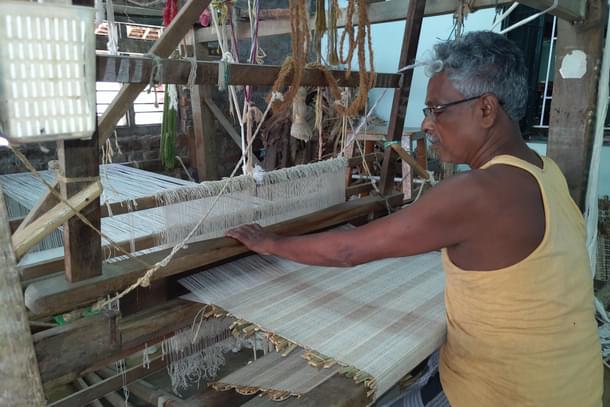
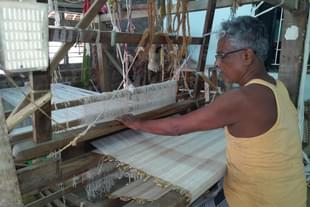
According to marketing studies by health-care experts and lifestyle product dealers, the last two years have seen a rise in the sale of organic yoga mats — a natural product that doesn’t sacrifice on style or comfort.
We bring you details on the making of organic, eco-friendly, and sustainable organic yoga mats.
Switch to Earth-friendly Options
Among the many who have wanted to take up weaving organic yoga mats are Tamil Nadu’s two young engineering graduates who jumped into the earth-friendly industry “just to make a difference to society and lend a hand to making the weaving trade flourish.”
Ashok Jegadeesan, 30, and Prem Selvaraj, 28, were part of an organic workshop held recently at the arts revival boutique "Madhurya Creations" in South Bengaluru.
Madhurya deals with the restoration of nearly 75 handmade crafts to see them survive and help people turn to organic inventions.
“In our monthly organic workshop meet, we have two young and spirited professionals involved in running a weaving centre for yoga mats. Why Madhurya wanted to source yoga and meditation mats and herbal-dyed towels from Ashok Jegadeesan and Prem Selvaraj is because of their organic process of fair-trade brought in," says Bharathy Harish, Chief Co-ordinator at Madhurya.
"Their endeavour has brought in nearly 200 artisans together in the region who will benefit from a steady income, while having their family’s weaving legacy go on. All this is made possible only with passionate professionals like Ashok and Prem promoting the art, while it helps people like us turn to them to have our revival interest in crafts reach out to people,” she adds.
Last year, Madhurya Creations even helped reach out to weavers and artisans through yoga and meditation programmes across India for their well-being and to help them recuperate from the negative impact of the pandemic, as weavers have been left feeling anxious and helpless seeing their trade dwindling due to a lack of demand.
Their Background Formed Their Foundation
Although Ashok and Prem came from a handloom weavers background, the mechanical engineering study they took up was not just to gain a good education, but also to make sure their employability would be increased, so they can support their family's measly incomes.
After the brothers graduated from colleges in Coimbatore and Salem respectively, they put their heads and hearts together to make sure that their heritage profession was not left behind.
While they wished to take up jobs, they were equally determined to make their engineering education relevant.
“In 2015, we took the bold step of steering the large-scale weaving of organic yoga and meditation mats and herbal-dyed towels to East Kathalapettai, Komarapalayam, in Tamil Nadu, where we live. It is 15 km from Erode in Namakkal district," Ashok says.
"Our professional background helped us set up the required looms, even as we convinced several people in the village to join us in reviving handlooms and bring out innovative mats that were in demand," he adds.
What Ashok and Prem fondly remember is their years growing up, when homes in their neighborhood were only surrounded by weavers’ looms.
“We would wake up to the clickety-clack sound of the weaving! The principal occupation here was just handloom. The region had nearly two lakh weavers of every kind doing towels, saris, and the popular ‘Bhavani jamakalam’ or the Bhavani floor mat. It’s painful to see just about 2,000 weavers now left in the profession owing to ‘no demand'," Prem says.
"We noticed that the last decade had a boom in yoga awareness worldwide, so after our study, we thought the time was perfect to invest in weaving yoga mats with organic material. Soon, we built a team for taking care of all aspects of weaving, starting with the people to collect river grass,” he adds.
Artisans here were already skilled in mat weaving, albeit of a different kind with Bhavani jamakalam. “We have helped many people turn towards weaving from agriculture. That has helped senior weavers earn steady wages while many women are also part of the trade now,” he explains.
All the products at Ashok and Prem’s unit are made with the ethos of conscious commerce, they say, while explaining to us how they are working on making 15 varieties of yoga mats while utilising the skills of experienced rural artisans as part of the team.
The mats retain their original grass colour as no synthetic dyeing is involved “as the mat’s proximity to the skin for nearly 90 minutes a day has to exude its natural properties to get skin-friendly.” In Ayurveda, it is proved that Samba grass has a cooling effect on the skin and senses while banana fibre has a thermal effect.
Mats from wild grass like Samba, Darbha, and banana fibre are made. “All the dyes used in organic cotton products, including mats and towels, are herbal. Our unit has 10 varieties of yoga mats in organic cotton too, and we have also brought in natural rubber backing in some to elevate their anti-skid nature,” explains Ashok.
There are yoga and meditation mats available separately. The grass ones have natural sweat-absorbent properties. Yoga mats are generally 72 inches in length and 26 inches in width, costing in the range of Rs 1,000 to Rs 3,000 depending on the grass and weave.
Mat Making
The traditional handmade process involves the cutting of riverside grass to a specified length, and left for secondary drying in the sun shade. This kind of indirect drying helps to have the yarn made easily, even as they are spliced to take them on for hand-weaving. As they are not dyed, it retains its natural green, light green, brown, and off-white shades of grass.
Organic cotton mats, on the other hand, are dyed (if there is a specific demand) with turmeric, indigo, neem, tulsi, and karungali tree extract, among other things.
“It takes a day for a weaver to make two mats on his own, and the unit is into making nearly 15,000 mats in a year, with 70 per cent getting exported to the US, UK, parts of Europe, Arab countries, Australia, and New Zealand,” Ashok says, adding that he is happy to make a difference when power looms are threatening to uproot the business of handmade craft, which is losing significance owing to the large costs involved.
And what more features does he plan as part of his innovative approaches? “We have received a good response from our customers abroad. With raw materials being natural and medicinal that transmits positive vibes for yoga, we plan to have eco-friendlier accessories as yoga wear, or revive the art of yoga rugs that were once famous in Mysore yoga rugs!” Ashok says.
“Darbha grass, also referred to as Kusha grass, radiates purifying powers that can be attributed to its ability to absorb negative vibrations. Conventional uses had them for doing asanas and meditation as they were considered cooling too,” says a senior member of the weaving artisans’ group.
Ask Ashvini Jagadale, a digital marketing executive, why she picked up an organic yoga mat, and she says, “I have long used a cobalt blue yoga mat that I bought from a neighbourhood store for my regular kriya practice when I was in Pune. Although it was nice and never fell short on function for quite a few years, I later came to know that conventional yoga mats were made of polyvinyl chloride (PVC), considered one of the most destructive environmental pollutants. I thought it was time I entered the natural world. I chose an organic cotton one, dyed with neem, which is anti-inflammatory and anti-bacterial, with a rubber backing for grip,” beams Ashvini.
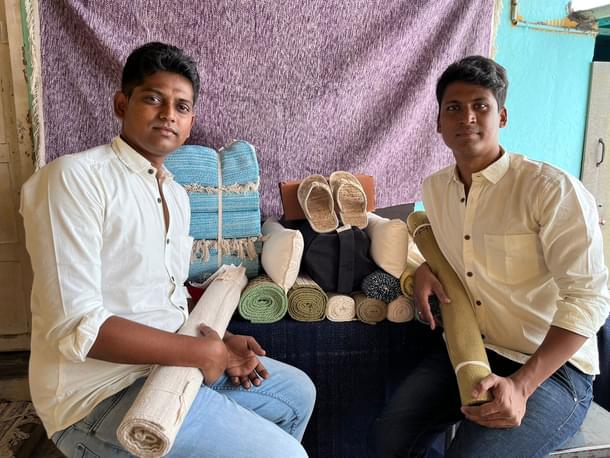
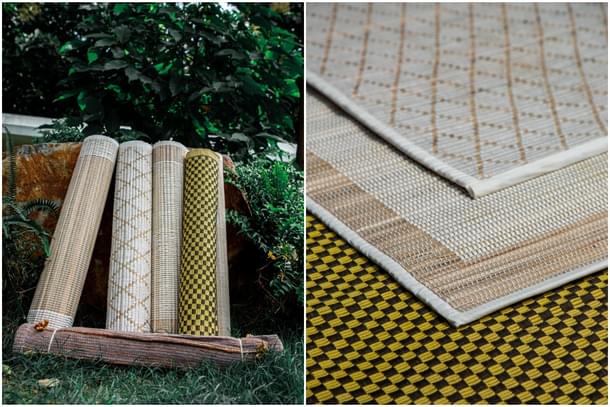
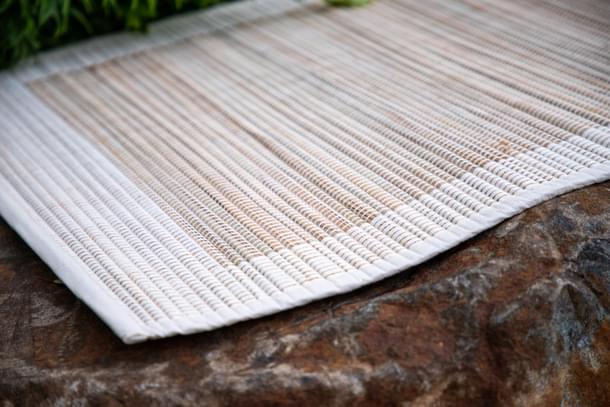
More Eco-friendly Options
* The Mumbai-based ‘Kosha Yoga Co’ offers the ‘Foliage Yoga Mat’ crafted with natural rubber base using their new honeycomb construction to provide extra cushioning and grip with a microfibre-sweat absorbent top.
* The Bengal Mat offered by Bengaluru-based Proyog is a completely biodegradable and recyclable product where jute is added to each mat to keep it fresh and non-slippery for any kind of exercise.
* Juru Yoga in Chennai has come up with the ‘7 Chakra Print Cork Yoga Mat’ made from premium cork from Portugal and natural rubber from Kerala, with an anti-microbial surface for grip.
* Cork Yoga Mat by the Yoga Design Lab claims to be a blend of fashion design elements with pioneering functionality. Each yoga mat, made with cork and rubber base, has only biodegradable materials as natural rubber to recycled plastic bottle microfibres, and later printed with water-based ink for having the mandala patterns.
* Natural Cotton Yoga Mats by Kaashi Wellness are handwoven by artisans from Bhadohi in Uttar Pradesh, the largest hand-knotted carpet weaving industry hub in South Asia. Using 100 per cent natural cotton that is woven into a breathable fabric, it has been given an anti-skid treatment too.





